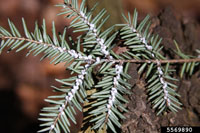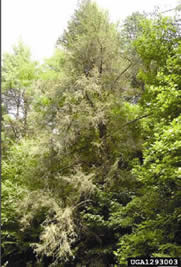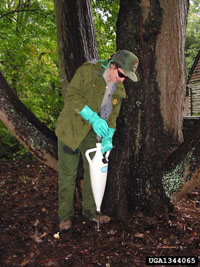Updated January 2020
Background

Hemlock Woolly Adelgid (HWA) is an invasive insect native to Japan. This aphid-like insect threatens hemlock trees in the eastern U.S. and has the ability to alter landscapes that include hemlock trees. Fourteen counties in the northern part of Georgia are included in the range of eastern hemlock (Tsuga canadensis) and two counties have Carolina hemlock (Tsuga caroliniana). HWA was first found in Georgia in 2003, and by 2012 it had spread throughout the entire state’s hemlock range (see GA map, see US map). Loss of hemlock in these areas is both ecologically and environmentally devastating. If it is eliminated, there is no other native conifer that will fill hemlock’s role in the forest.
Identification/biology
HWA is an aphid-like insect that uses its sucking mouthparts to feed on fluids from hemlock trees. From fall through early summer, they are visible as tiny white cotton-like balls on the underside of hemlock needles. This “cotton” or wool is actually a waxy layer that protects the aphid and its eggs. HWA has two generations per year and each female can lay up to 175 eggs each time.
Damage Caused

With two generations per year, HWA is capable of rapid population growth. In the Southeast, mild winters also allow greater numbers of HWA to survive the winter, leading to higher population grown than in the northeastern U.S. Once HWA has been introduced to an area, it feeds on the trees’ fluids, leading to their rapid decline. Here in Georgia, hemlocks can go from healthy, to a green-gray appearance with dead branches, to dead, within four years of an infestation. Loss of hemlock trees in a landscape leads to loss of ecosystem diversity and an increase in run-off into streams. This loss of shade in riparian areas also leads to higher stream temperatures and a decrease in aquatic species diversity.
What are we doing about it?
Protection of these trees is costly at both the urban and landscape levels. There are several management options available for different levels of homeowners/landowners. At the landscape level, biological and chemical control are options currently being used in Georgia. Historically, these have been used in separate areas. However, combinations of chemical and biological control at the same site are also being used, allowing the establishment of biological controls while protecting trees for the immediate future. Other potential options under development include genetic resistance and forest stand management strategies. At the homeowner level, chemical control is the most practical option.
HWA causes damage to the tree by feeding on the starch the tree produces. This inhibits the tree’s ability to produce new growth. All ages and sizes of hemlocks can be attacked. Trees that have been infested for a couple of years will have a declining appearance. The needles of the thinning crown will have a dull green to gray color (Figure 3) and lower branches will begin to die. Tree mortality usually occurs after 3-5 years of heavy infestation.
Biological Control
Georgia has been using biological control measures for HWA since its initial detection in 2003. Biological control uses natural enemies of a pest to keep population numbers low and decrease the negative effects of the pest. These are usually used at the landscape level over long periods of time. Here in Georgia, we have utilized the help of the University of Georgia, the University of North Georgia, Young Harris College and (previously) Clemson University in the rearing and releasing of predator beetles in HWA infested areas. To date, we have released five species of predatory beetles, numbering in the millions. Since 2016, these releases have been concentrated in six areas that we hope will become field insectaries. With the rising costs of raising predator beetles in labs and other environmental factors, these insectaries will be a place where predator beetles can be collected in the wild and moved to other sites. Two more predators, L. osakensis and Leucopis spp., are currently being assessed for release.
Chemical Control

For homeowners, contact and systemic insecticides are the most practical methods available for treating HWA. Of these two, systemic insecticides are often the best choice for individual homeowners. Two insecticides most used for HWA suppression are imidacloprid and dinotefuran. See these articles for explanations of insecticide treatments: Hemlock Woolly Adelgid Management in Georgia (McCarty and Womack) and Optimized Insecticide Dosage for Hemlock Woolly Adelgid Control (Benton). Care should be taken when applying systemic insecticides, including wearing personal protective equipment, being mindful of the site conditions and following label instructions. If you have more questions about chemical applications, please contact your forest health specialist.
Spread the word
Encourage your neighbors to protect their trees and help everyone protect Georgia’s hemlocks!
HWA Soil Drench Application
- For specific instructions on Drench Application, please see HWA Soil Drench Treatment Instructions.
- For specific instructions on Soil Injection Application, please see HWA Soil Injection Instructions.
- 2020 Hemlock Woolly Adelgid in Georgia (brochure)
- Biology and Management of the Hemlock Woolly Adelgid in the Eastern U.S.
- Environmental Risks to Arthropods from Imidacloprid Applications for Hemlock Conservation
- Hemlock Woolly Adelgid (HWA) in Georgia Fact Sheet
- Hemlock Woolly Adelgid Infographic
- Hemlock Woolly Adelgid Management in Georgia (2019)
- Hemlock Woolly Adelgid U.S. Map (2019)
- HemlockFest Website
- Insecticide Applicators and Vendors for Hemlock Woolly Adelgids
- Lula Lake Land Trust Website
- Optimized Insecticide Dosage for Hemlock Woolly Adelgid Control in Hemlock Trees
- Southern Regional Extension Forestry – Hemlock Woolly Adelgid
- U.S. Forest Service – Hemlock Woolly Adelgid
- University of North Georgia Ecological Protection Lab
- YHC – Hemlock Project

We are considering planting Eastern Hemlock trees as a screen on our property in Rabun County, Georgia. Should we reconsider based on the HWA problem in our area? We would appreciate your input.
Today I noticed some eastern hemlock trees in the Leita Thompson Memorial Park are infected with Woolly Agdelgid. Do I need to report this somewhere so they can be taken care of? I have pictures of the bugs on the needles.